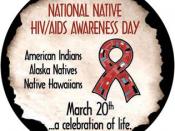Human history accounts many large scale epidemics that have devastated and destroyed populations, such as the Black Plague, cancer and now in the last two decades AIDS. Acquired Immunodeficiency Syndrome or AIDS was first identified in 1981 caused by the Human Immunodeficiency Virus (HIV) discovered two years after AIDS. AIDS victims acquire the virus from receiving bodily fluid from an infected victim. AIDS attacks the immune system, leaving the victim helpless and weak. Symptoms include fever, extreme weight loss, enlargement of glands, and pneumonia (King, Alan J.C. et al, p1).The virus is most commonly passed through sexual activity, oral, anal and vaginal. However AIDS may be transmitted through any exchange of bodily fluids, from open wounds or sores, sharing a razor with an infected victim's blood on it, sharing needles, and blood circulation from an infected impregnated woman to her unborn child. The disease may infect anyone, and is not a stereotype bound disease.
In 1996, there were 16,913 cases of AIDS reported in Canada and 50,000 HIV cases. Newly infected homosexual patients constituted 30% of HIV patients, while 47%were injecting drug users (Health Canada, Web).
From these statistics, classing an AIDS/HIV patient as a male homosexual or a drug user seems easy. Anyone, despite ethnicity, race and gender may catch AIDS. However, the typical AIDS patient is thought to be male. From this information, would a female then be willing to admit contracting the virus when she knows that hiding the virus from others would be easier and safer simply. When dealing with the subject of AIDS, not only do patients need physical care, but mental care as well. Thoughts of alienation, stigmas from family and community, misinformation about AIDS, and most likely denial about the disease would deter many women from revealing that they have contracted AIDS or...


